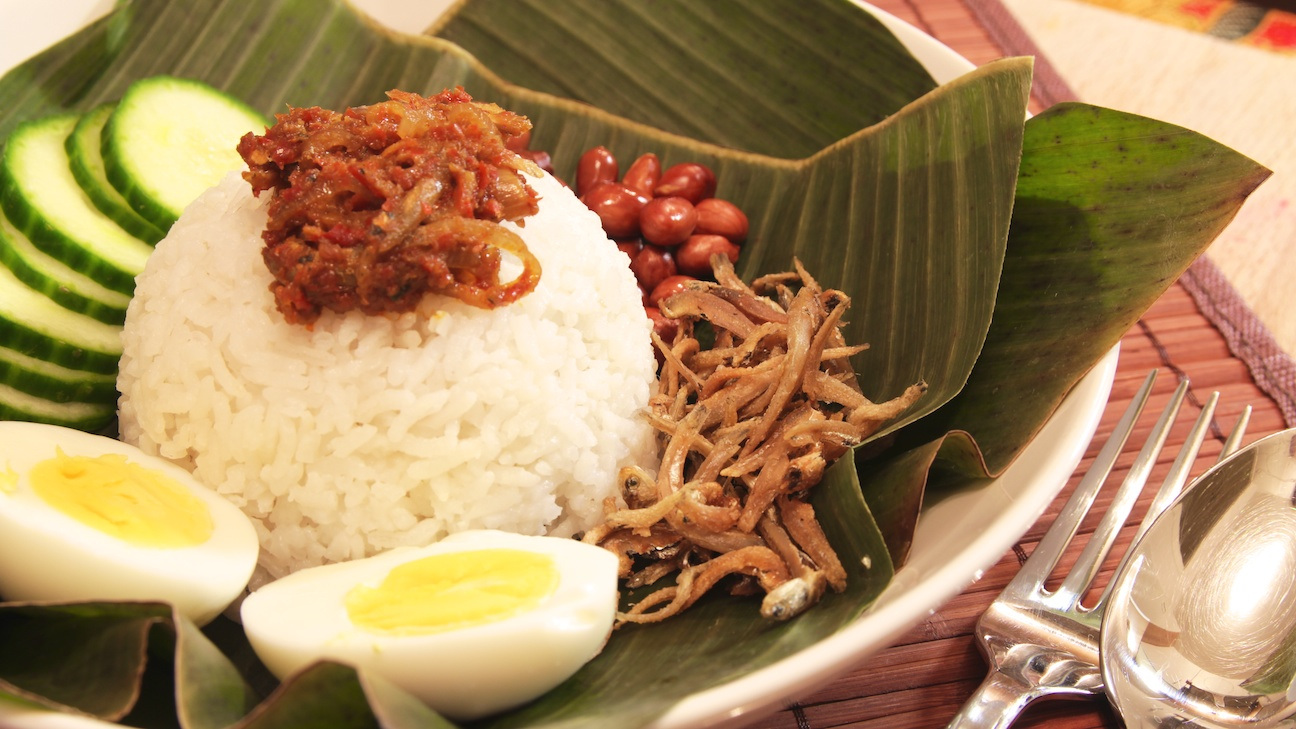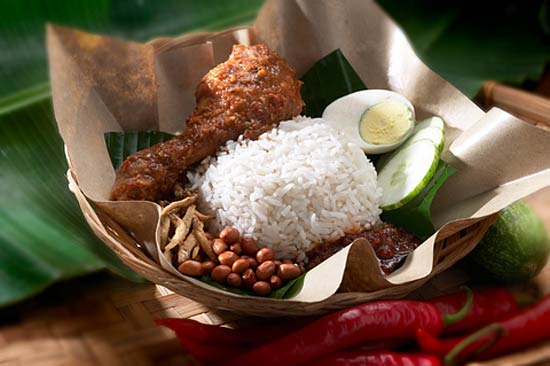
 |
| Home|Nasi Lemak|Nasi Kerabu|Ais Kacang|Satay|Roti Canai |
Nasi Lemak  History Nasi lemak was
mentioned in a book "The Circumstances of Malay Life", written Sir Richard Olof Winstedt in 1909. With roots in Malay
culture and Malay cuisine, its name in Malay literally means "oily or fatty
rice", but is taken in this context to mean
"rich" or "creamy". The name is derived from the
cooking process whereby rice is soaked in coconut
cream and then the
mixture steamed. The rice is normally cooked with pandan leaves that gives it a
distinctive flavour. Traditionally, nasi lemak is served with a hot spicy sauce (sambal),
and usually include various garnishes, including fresh cucumber slices, small
fried anchovies (ikan bilis), roasted peanuts, and hard-boiled or
fried egg. As a more substantial meal, nasi lemakmay also be
served with an additional protein dish such as ayam goreng (fried
chicken), sambal sotong (cuttlefish in chili), small fried fish, cockles, and on special occasions rendang daging
(beef) stewed in coconut milk and spices). Other accompaniments include
stir fried water convolvulus (kangkong), and
spicy pickled vegetables salad acar.
Traditionally most of these accompaniments are spicy in nature. Nasi lemak is widely eaten in Malaysia and Singapore. More
commonly consumed as breakfast in both countries, it is commonly sold at hawker
food centres and roadside stalls in Malaysia and Singapore. In Indonesia, nasi
lemak is a favourite local breakfast fare; especially in Eastern Sumatra (Riau
Islands, Riau and Jambi provinces). In Palembang, it is also a favourite local dish with the
name "nasi gemuk". In palembangnese malay, "gemuk" has the
same meaning as "lemak". This unique dish often comes wrapped in
banana leaves, newspaper or brown paper, or it in some shops served on a plate.
However, owing to its popularity there are restaurants which serve it as a noon
or evening meal, making it possible for the dish to be eaten all day. Nasi
lemak kukus which means "steamed nasi lemak" is another name
given to nasi lemak served with steamed rice. In Malaysia, nasi lemak also can
be found in a pasar malam (night market) with a variety of dishes.  How To Cook ? Recipe: Nasi Lemak Ingredients:
Coconut Milk Steamed Rice
2 cups of rice 3 screwpine leaves (tie them into a knot as shown above) Salt to taste 1 small can of coconut milk (5.6 oz size) Some water Tamarind Juice Sambal Ikan Bilis (Dried anchovies sambal) Other ingredients Method Method: • Just like making steamed rice, rinse your rice and drain. Add the coconut milk, a pinch of salt, and some water. Add the pandan leaves into the rice and cook your rice. • Rinse the dried anchovies and drain the water. Fry the anchovies until they turn light brown and put aside. • Pound the prawn paste together with shallots, garlic, and deseeded dried chilies with a mortar and pestle. You can also grind them with a food processor. • Slice the red onion into rings. • Soak the tamarind pulp in water for 15 minutes. Squeeze the tamarind constantly to extract the flavor into the water. Drain the pulp and save the tamarind juice. • Heat some oil in a pan and fry the spice paste until fragrant. • Add in the onion rings. • Add in the ikan bilis and stir well. • Add tamarind juice, salt, and sugar. • Simmer on low heat until the gravy thickens. Set aside. • Clean the small fish, cut them into half and season with salt. Deep fry. • Cut the cucumber into slices and then quartered into four small pieces. • Dish up the steamed coconut milk rice and pour some sambal ikan bilis on top of the rice. • Serve with fried fish, cucumber slices, and hard-boiled eggs. |